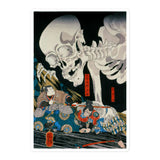'Takiyasha the Witch and the Skeleton Spectre' by Utagawa Kuniyoshi, ca. 1844. Middle panel of the triptych. This image is also available on:
The direct inspiration for this scene is Santo Kyoden's 1806 work 'The Tale Of Zanchi Yasukata's Loyalty', in which the orphaned children of the rebel Taira no Masakado try avenge their father's execution. In this scene, Masakado's daughter Takiyasha summons a gigantic skeleton in the ruins of their mansion to frighten off Mitsukuni, an agent of the Imperial Court.
The ultimate origin of the story is the life of historical figure Taira no Masakado, who died around 939 after a failed rebellion against the central government in Kyoto. The Taira clan was a branch of the Imperial House and Masakado's rebellions started out as a family squabble, either over a marriage, the theft of some of Masakado's lands by an uncle, or lingering resentment against the Emperor for the demotion of the Taira from Imperial princes to commoners (or possibly all three). Masakado's first rebellion was triggered when he was ambushed by three of his cousins; not only was he able to defeat and kill them, he went on to lead his hundred or so retainers to defeat an army of several thousand gathered by his uncles. He managed to get to Kyoto and plead his case to the Emperor, which resulted in light punishment, but the bad blood remained and Masakado rebelled again, this time for full independence from Kyoto. This rebellion ended in Masakado's defeat and decapitation.
The history of Masakado's rebellion provides an invaluable insight into the political situation of 10th century Japan; unlike in later centuries, the Emperor still ruled directly rather than being controlled by a Shogun, but in Masakado's defiance we see the first hints of the origins of the Shogunates. The north-eastern part of the Japanese archipelago still belonged to the native Emishi tribes (related to the Ainu people, now only found in small numbers in Hokkaido), and the Japanese clans that lived on the frontier were used to defending themselves without help from Kyoto and could field highly trained warriors that were a match for armies of peasant levies several times their number. These warriors would develop into a separate class, later known as 'samurai'.
Just as interesting is how Masakado was remembered by popular legend: instead of being vilified as a traitor he was deified, becoming a minor kami (Shinto god) in the western Kanto plain. Kami are not necessarily benevolent, and Masakado was often seen as more of an angry spirit to be appeased, but the fact that his story endured indicates a certain amount of sympathy for his rebellion against Kyoto in his home region. His tale became so embedded in folklore that almost nine hundred years later audiences still found it compelling enough for Santo Kyoden to use it for inspiration, and it continues to evolve: Kuniyoshi's depiction in this print led to a rare modern addition to Japanese folklore: Gashadokuro, a vengeful eighty-foot tall skeleton.
Product Details:
Sticker with three size options.
FREE SHIPPING
Sizes (longest side): 3", 4", 5.5"
Average Delivery Time: 3 - 6 working days
• High opacity film that’s impossible to see through
• Fast and easy bubble-free application
• Durable vinyl, perfect for indoor use
• 95µ density
• Applies best to clean surfaces






